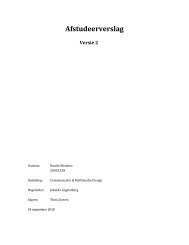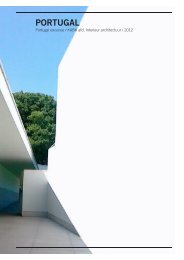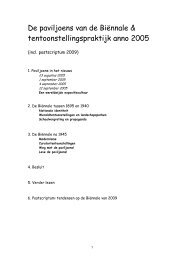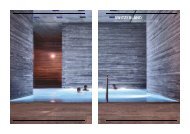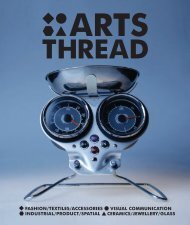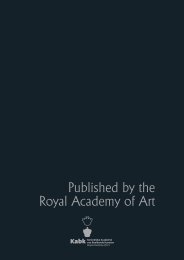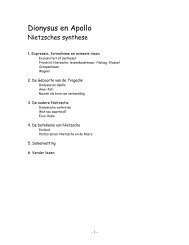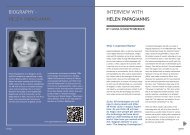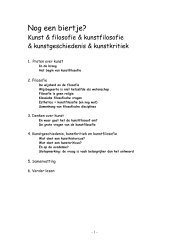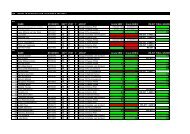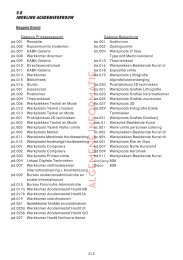download LR pdf - Kabk
download LR pdf - Kabk
download LR pdf - Kabk
Create successful ePaper yourself
Turn your PDF publications into a flip-book with our unique Google optimized e-Paper software.
oom in my head. I have it in myinner vision and I think in pictures.There is a photo register in myhead which I can access. It’s a bitlike parking a car. I can park a carin a very small space extremelywell. I can feel the car around meand I can feel the space I want toput it in. It’s the same with theart I create. Once I have clear ideaof the artwork I want to create, Iuse Cinema4D software to make3d models. Then I use BuildAR toplace my 3d models it the realspace. If everything goes well,things happen that you could nothave imagined.”A result of this process is, for example, the ARinstallation Out of the blue which was shownat Today’s Art festival in The Hague in 2007:“The idea behind ‘Out of theblue’ came from a photographI took in an elevator. I took thepicture so that the lights in theelevator looked like white ellipseson a black background. Itook this basic elliptical shapeas a basis for working in a verybig space. I was very curious if Icould use such a simple shape andstill convince the audience that itreally existed in the space. Andit worked — people tried to touchit with their hands and were verysurprised when that wasn’t possible.”The fact that people believe in the existence ofher virtual objects is also important for Marina’spersonal understanding of AR:“For me, Augmented Realitymeans using digital images tocreate something which is notreal. However, by giving meaningto it, it becomes real and peoplerealize that it might as wellexist.”I wonder whether there is a specific place orspace she’d like to augment in the future andMarina has quite some places in mind. They haveone thing in common: they are all known museumsthat show modern art.“I would love to create worksfor the big museums such as theTATE Modern or MoMa. In theNetherlands, I’d love to augmentspaces at the Stedelijk Museum inAmsterdam or Boijmans museumin Rotterdam. That’s my world.Going to a museum means a lotto me. Of course, one can placeAR artworks everywhere, also inpublic spaces. But it is importantto me that people who experiencemy work have actively chosen togo somewhere to see art. I don’twant them to just see it by accidentat a bus stop or in a park.”Rather than placing her virtual models in a specificphysical space, her current work follows adifferent approach. This time, Marina will placethe animated dying animals in the hands of theaudiences. The artist has some ideas about howto design this physical contact with the digitalanimals.“In order for my piece to work,the viewer needs to feel like heis holding something in his hand.Ideally, he will feel the weight ofthe animal. The funeral monumentswill therefor have a certainweight.”It is still open where and when we will be ableto experience the piece:“My residency lasts 10 weeks. Butof course that’s not enough timeto finish. In the past, a piece wasfinished when the time to work onit was up. Now, a piece is finishedwhen it feels complete. It’s somethingI decide myself, I want tohave control over it. I don’t wantany more restrictions. I avoiddeadlines.”Coming from a fine arts background, Marina hasa tip for art students who want to to follow inher footsteps and are curious about workingwith AR:“I know it can be difficult to combinetechnology with art, but it isworth the effort. Open yourselfup to for art in all its possibilities,including AR. AR is a chanceto take a step in a direction ofwhich you have no idea whereyou’ll find yourself. You have tobe open for it and look beyondthe technology. AR is special —I couldn’t live without it anymore...”64 65



